Moving a roll-off dumpster seems simple until you realize these containers weigh thousands of pounds when empty and much more when loaded. Many people discover this reality too late during home decluttering projects or construction jobs.
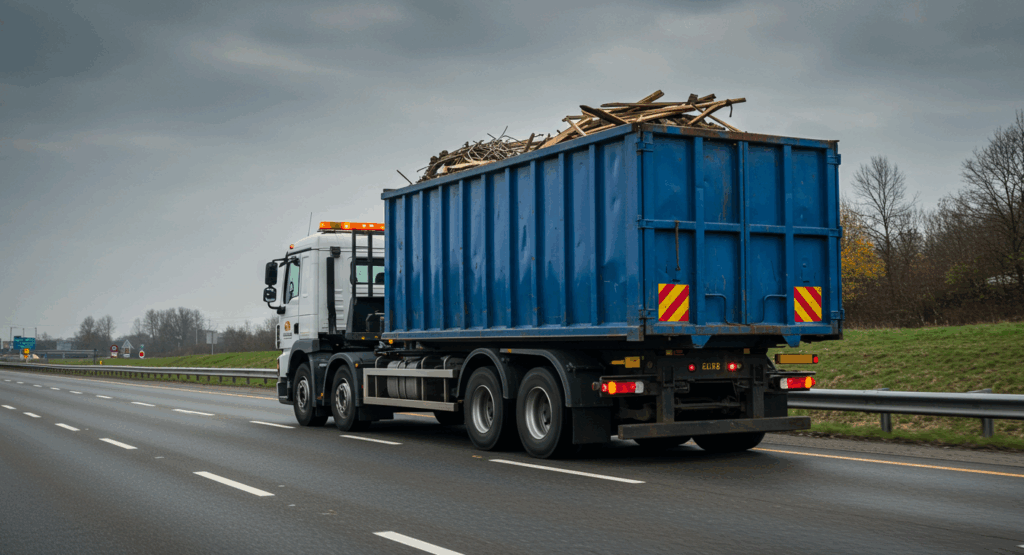
Professional dumpster relocation requires specialized equipment like hydraulic trucks and experienced crews who understand weight distribution and safety protocols. Attempting to move these containers without proper tools often leads to property damage, injury, or both.
This guide covers when to call professionals, what preparation steps matter most, and why certain debris types make relocation nearly impossible. You’ll also learn about real failed attempts and the true costs involved in dumpster moves.
When Roll-Off Dumpsters Relocation Should Be Left To The Pros
Never attempt moving a roll-off dumpster yourself. These containers require professional equipment and trained operators for safe relocation.
Even empty 20-yard dumpsters weigh around 3½ tons. When filled with construction debris or materials, they can reach 10-15 tons. This weight makes them dangerous for anyone without proper moving equipment.
Rental agreements typically prohibit customer relocation. Moving a dumpster without permission can void your rental contract. Insurance coverage may also be canceled if damage occurs during unauthorized moving.
Several safety risks make DIY moving extremely hazardous:
- Property damage from heavy containers scraping driveways or lawns
- Personal injury from attempting to lift or push massive weights
- Equipment failure when rollers bind or skids catch on pavement
- Overhead hazards like power lines that professionals know to avoid
Professional waste management companies use specialized trucks and hydraulic systems. These tools safely lift and transport containers without ground contact. Trained operators also understand proper positioning and clearance requirements.
Standard rental services include initial placement and final pickup. Most companies offer mid-rental repositioning for an additional fee. This professional service costs far less than potential property damage or medical bills from DIY attempts.
Contact your waste management provider if relocation becomes necessary. They can assess the site and schedule safe moving using appropriate equipment and trained personnel.
Before You Call For A Move: Checklist For Safe Relocation
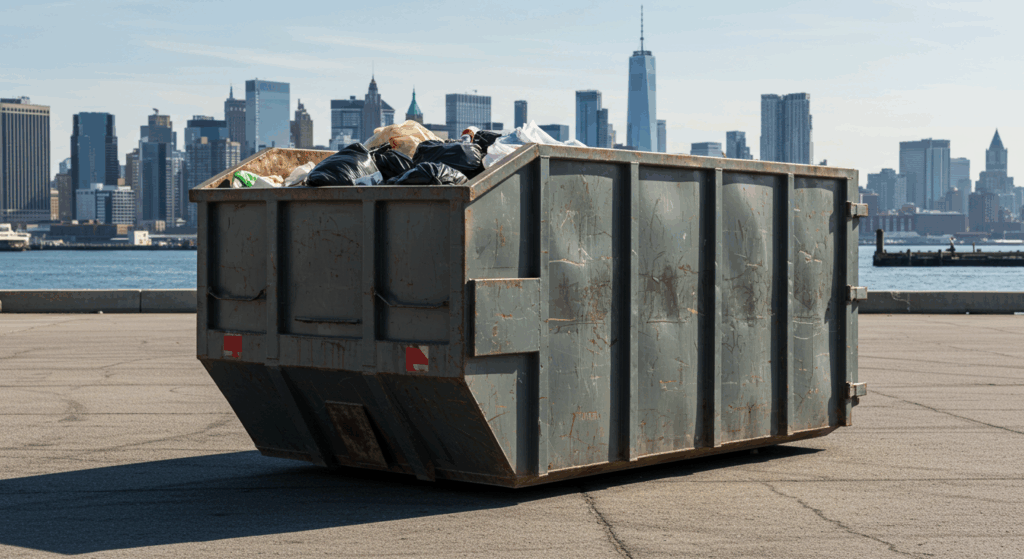
Moving a roll off dumpster requires careful planning. Check these items first to avoid problems during relocation.
Check the ground conditions where the dumpster will go. The surface must be firm and level. Concrete, asphalt, or packed gravel work best.
Soft ground can cause the dumpster to sink or tip. Avoid placing roll-off dumpsters on grass, dirt, or sloped areas.
Clear the path completely. Remove all obstacles within 15 feet around the dumpster. This includes cars, tools, and yard equipment.
Check overhead space too. Power lines, tree branches, and structures need at least 14 feet of clearance above the roll off dumpster.
Protect your property from damage. Place plywood sheets or protective mats under the dumpster. This prevents scratches on driveways and walkways.
Prime dumpster companies recommend using half-inch plywood for concrete surfaces. Thicker materials work better for asphalt.
Confirm important details with your waste company. Ask about weight limits for the new location. Find out if permits are needed for the move.
Schedule the relocation during business hours when possible. Most companies charge extra for weekend or evening moves.
Measure the distance carefully. Short moves of 1-2 feet are different from longer relocations. Roll-off dumpsters that are full need professional moving equipment.
Empty or partially full containers are easier to reposition safely.
What Dumpster Crews Actually Do: The Professional Procedure
Professional crews follow strict safety steps when moving roll-off dumpsters. They never guess or rush the process.
Pre-Movement Setup
Operators start by adjusting the roll-off truck bed to the right angle. They check and lock all attachment points before touching any controls.
The crew then engages lift cables or hydraulic hooks. Each connection gets tested before lifting begins.
Container Release Process
Most dumpsters have built-in wheels or metal skids underneath. Technicians gently rock the container back and forth to break it free from the ground.
This prevents the dumpster from sticking to dirt or pavement. The movement also checks that nothing blocks the path.
Safe Dumpster Loading
Movement happens slowly using hydraulic systems only. Crews never tow or push dumpsters with separate vehicles.
| What They Do | What They Don’t Do |
|---|---|
| Use hydraulic lifts | Push with trucks |
| Move containers slowly | Rush the process |
| Test all connections | Skip safety checks |
This controlled approach prevents sudden shifts. It also protects both the dumpster and truck from damage.
Final Placement Steps
Once the dumpster reaches its new spot, operators re-lock all mechanisms. They inspect the container and surrounding area for any problems.
The customer confirms the new location works correctly. Crews also verify the dumpster sits level and stable before leaving the site.
How Loading Method & Debris Type Affect Moveability
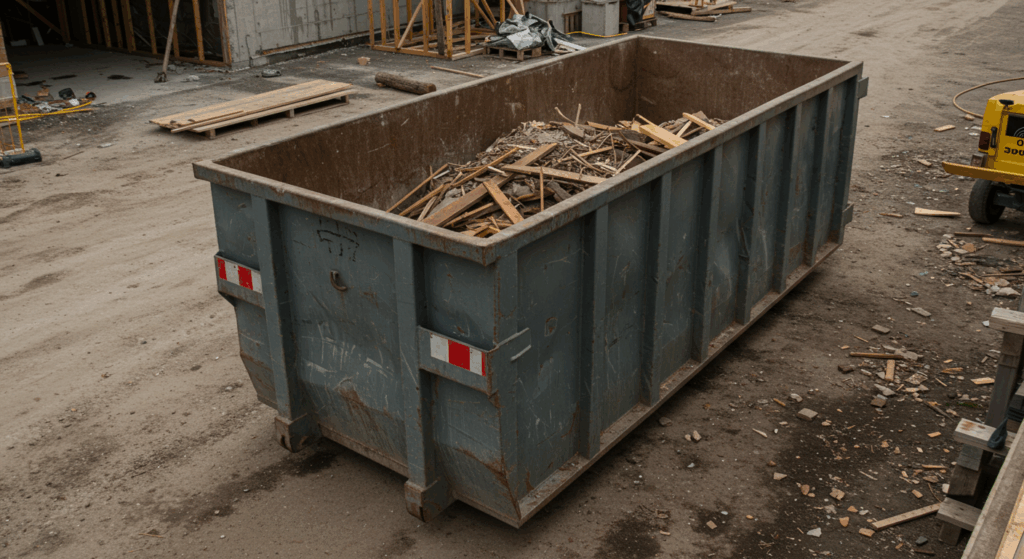
Proper loading makes the difference between a smooth dumpster move and equipment damage. Heavy debris loaded incorrectly can jam rollers or crack the container base.
Start with heavy materials like concrete and bricks at the bottom. Place lighter items such as drywall and household trash on top. This method prevents the dumpster from tipping during transport.
Weight distribution affects how well the container rolls. One cubic yard of broken concrete weighs around 4,000 pounds. The same amount of drywall weighs only 750 pounds.
| Material Type | Weight per Cubic Yard | Loading Priority |
|---|---|---|
| Concrete/Brick | 4,000 lbs | First (bottom) |
| Soil/Sand | 2,500 lbs | Second |
| Drywall | 750 lbs | Third |
| Household Trash | 300 lbs | Last (top) |
Uneven loads create problems. Material piled on one side prevents smooth rolling and can damage the dumpster’s frame. Spread debris evenly across the container’s length and width.
Dumpster size determines weight limits. Most 10-yard units handle 1-2 tons safely. Larger 30-yard containers typically allow 3-4 tons maximum.
Exceeding weight limits makes moving impossible. The container becomes too heavy for standard equipment and may require special handling fees.
Dense materials like dirt or concrete fill containers quickly. Choose the right dumpster size based on debris type, not just volume needs.
Real Attempts That Went Sideways: Why These DIY Moves Failed
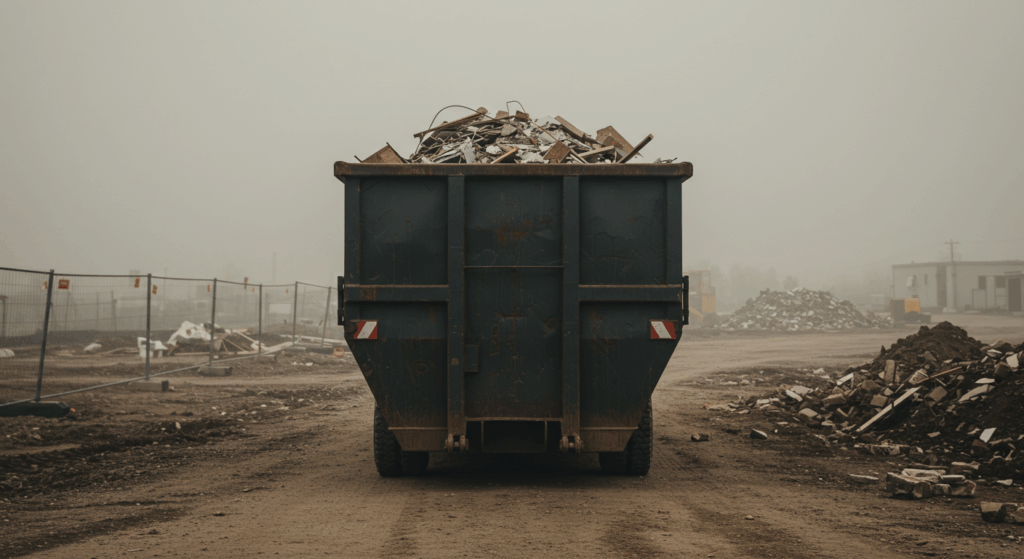
Several homeowners have attempted to relocate dumpsters on their own. These cases show what can go wrong when people skip professional services.
The Tractor Chain Experiment
One customer used chains and a front-end loader to move a 2-yard bin. He reported success, saying it was “a piece of cake.” This worked only because conditions were perfect.
The dumpster was nearly empty. The driveway was completely flat. The bin weighed much less than normal.
The Pickup Truck Disaster
Another person tried towing a 10-yard dumpster with a Ford Maverick. The container held about 20,000 to 30,000 pounds of debris.
The truck could not budge the dumpster at all. The attempt risked serious damage to the vehicle’s drivetrain. Professional movers had to be called anyway.
What These Cases Teach
| Attempt | Weight | Result | Issue |
|---|---|---|---|
| Tractor pull | Light load | Success | Only worked due to ideal conditions |
| Truck tow | 20,000+ lbs | Complete failure | Equipment not suited for task |
Even small movements require specific conditions. The ground must be level and clear. The dumpster needs proper rollers or wheels. The load must be minimal or completely empty.
Most DIY attempts fail because people underestimate the weight and complexity involved.
Cost Factors Related To Moving Your Dumpster
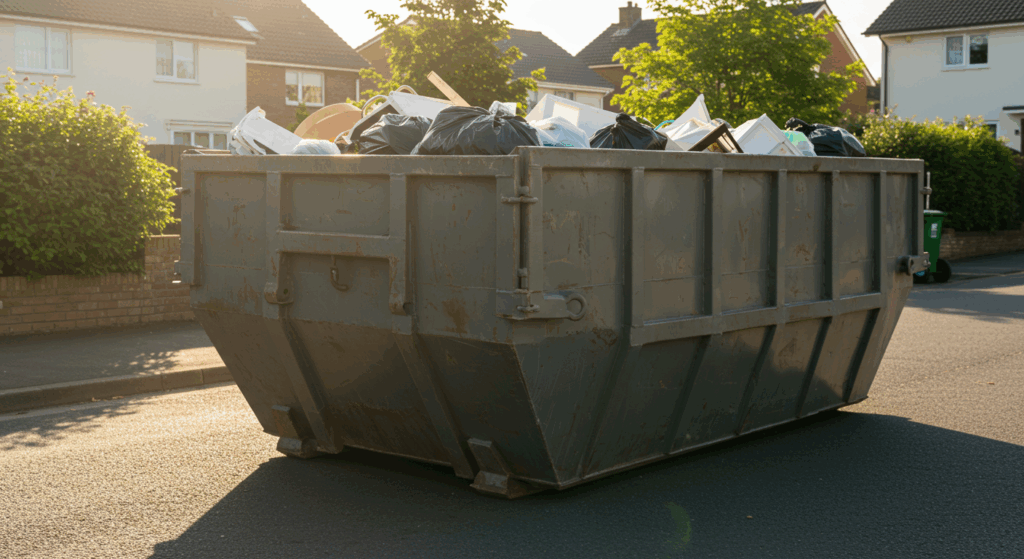
Moving a roll off dumpster involves several costs that can add up quickly. Most waste management companies charge fees beyond the basic rental price.
Relocation charges hit your budget first. Even moving the container a few feet typically costs $50 to $150. Some companies charge flat fees while others bill for extra driver time or additional trips.
Permit requirements create another expense. Cities require permits when dumpsters sit on public streets or sidewalks. These permits cost between $10 and $100 per week depending on your location.
| Cost Factor | Price Range |
|---|---|
| Relocation Fee | $50-$150 |
| Permit Fee | $10-$100/week |
| Weight Overage | $60-$100/ton |
Weight penalties can stop your move entirely. Waste disposal companies charge $60 to $100 per extra ton over the limit. Overweight dumpsters sometimes cannot be moved at all until contents are removed.
Property damage becomes your responsibility during relocation. Fresh concrete, asphalt, or indoor flooring can crack under the dumpster’s weight. Many rental agreements make customers pay for repairs.
Multiple moves multiply these costs. Each time you relocate the container, expect new fees. Plan your placement carefully to avoid unnecessary moves.
Ask for itemized estimates before signing contracts. This helps you understand exactly what each service costs and prevents surprise charges later.
Quick Reference Checklist: Is Your Site Move-Ready?
Before moving a roll off dumpster, check these key items to avoid delays and extra costs.
Ground Conditions
The surface must be flat and firm. Soft ground or steep slopes can damage the truck or property. Request gravel pads if the area is uneven.
Clear the Path
Remove all obstacles within 10-15 feet of the dumpster. This includes cars, tools, and low branches. The truck needs room to maneuver safely.
| Item | Action |
|---|---|
| Vehicles | Move at least 15 feet away |
| Tree branches | Trim to 20+ feet height |
| Tools/equipment | Store in garage or shed |
Weight Limits
Know the weight allowance for the dumpster size. Most 20-yard containers hold 2-4 tons. Going over costs $50-100 per extra ton.
Heavy items like concrete or dirt fill containers quickly. Mix light and heavy materials when possible.
Permits and Access
Street placement often requires permits. These cost $10-100 depending on the city. Some waste companies handle permits automatically.
Professional Service
Book the move service in advance. Confirm the date and time window. Most companies offer 2-4 hour arrival windows.
Have someone available to guide the driver if the location is hard to find.
Final Reminder: Never Risk Safety For Convenience
Moving a roll-off dumpster without proper equipment puts people at serious risk. These containers weigh thousands of pounds when empty. Even a small shift can cause crushing injuries or property damage.
Professional equipment makes the difference:
- Heavy-duty rollers designed for container weight
- Hydraulic lifting systems
- Specialized towing attachments
- Safety chains and securing mechanisms
Many people think they can save money by moving dumpsters themselves. This decision often leads to expensive repairs or medical bills. Professional waste management companies carry insurance for equipment failures.
Personal vehicles cannot handle dumpster weight safely. Trucks, trailers, and SUVs lack the proper attachment points. The strain can damage transmissions, axles, and suspension systems.
| Risk Factor | Potential Consequence |
|---|---|
| Improper lifting | Back and muscle injuries |
| Equipment failure | Property damage |
| Vehicle overload | Mechanical breakdown |
| Unstable load | Traffic accidents |
Warning signs to stop immediately:
- Vehicle struggling or making unusual noises
- Dumpster shifting during movement
- Damage to ground surface
- Anyone working without proper safety gear
Professional movers complete the job in minutes with the right tools. They understand weight distribution, proper lifting techniques, and safety protocols. Their equipment prevents the accidents that happen with makeshift solutions.
The small cost of professional service protects against major expenses later. Insurance claims, vehicle repairs, and medical bills far exceed rental fees.
Frequently Asked Questions
Moving roll-off dumpsters requires specific equipment and safety procedures. These common questions address transportation methods, weight considerations, placement options, security features, and location selection factors.
What is the appropriate method for transporting a roll-off dumpster?
Roll-off dumpsters require specialized trucks with hydraulic lift systems for safe transportation. The truck uses a cable and winch system to pull the container onto the truck bed.
Only trained operators should handle roll-off truck equipment. The hydraulic system lifts and lowers the truck bed to ground level for loading.
Standard pickup trucks cannot transport roll-off containers safely. The weight and size exceed typical vehicle capacity limits.
What is the average weight of a standard 20-yard roll-off dumpster?
A standard 20-yard roll-off dumpster weighs between 3,500 and 4,500 pounds when empty. The exact weight depends on the manufacturer and construction materials used.
Steel thickness affects the overall weight of the container. Heavier gauge steel increases durability but adds weight to the unit.
Most 20-yard containers measure 22 feet long, 8 feet wide, and 4 feet high. The size and weight require proper equipment for safe handling.
Can a roll-off dumpster be safely placed on a lawn without causing damage?
Roll-off dumpsters will damage most lawn surfaces due to their weight and size. The concentrated weight creates deep ruts and kills grass underneath.
Plywood sheets can distribute weight but may not prevent all damage. The protection works better on firm, dry ground conditions.
Concrete driveways or paved surfaces work best for dumpster placement. These hard surfaces handle the weight without permanent damage.
Property owners should expect lawn repair costs when placing containers on grass. Reseeding or resodding may be necessary after removal.
What is the correct procedure to secure or unsecure the latch of a roll-off dumpster?
Roll-off dumpsters use gravity-operated latches that engage automatically when doors close. The latch mechanism requires no additional securing steps.
To open the doors, lift the latch handle and swing the doors outward. Some latches include safety pins for extra security during transport.
Check that doors close completely and latches engage properly. Loose doors can open during pickup and create safety hazards.
Never attempt to modify or repair latch mechanisms yourself. Contact the rental company for latch problems or malfunctions.
What factors should be considered when selecting a location for a roll-off dumpster?
Choose locations with at least 60 feet of straight-line access for the delivery truck. The truck needs space to maneuver and position the container safely.
Overhead clearance must exceed 25 feet to accommodate the hydraulic lift system. Check for power lines, tree branches, and building overhangs.
Select firm, level surfaces that can support the combined weight of the container and contents. Avoid soft ground, slopes, and uneven terrain.
Keep containers away from septic systems, underground utilities, and sprinkler lines. Call 811 before placement to mark underground utilities.




